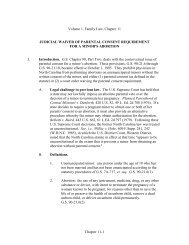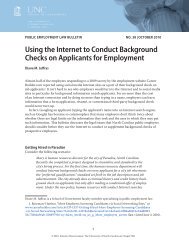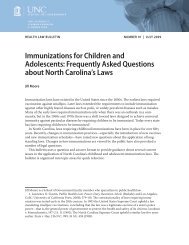Sentencing, Corrections, Prisons, and Jails - School of Government ...
Sentencing, Corrections, Prisons, and Jails - School of Government ...
Sentencing, Corrections, Prisons, and Jails - School of Government ...
You also want an ePaper? Increase the reach of your titles
YUMPU automatically turns print PDFs into web optimized ePapers that Google loves.
234 North Carolina Legislation 1998<br />
Other Correctional Programs<br />
Community Justice Partnership Program<br />
The Community Justice Partnership Program was created in 1994 to provide state assistance to<br />
local planning groups to plan <strong>and</strong> operate more <strong>of</strong> the community correctional programs that qualify as<br />
intermediate punishments under the SSA. In the beginning, the program <strong>of</strong>fered both discretionary<br />
grants <strong>and</strong> block (formula) grants to counties, pursuant to G.S. 143B-273.15. In 1997, the funding<br />
system was changed to block grants only. S.L. 1998-212 (S 1366), Section 17.5, continues that<br />
arrangement, amending S.L. 1997-443, Section 19.8, so that available funds may be distributed only as<br />
block grants during the remainder <strong>of</strong> the 1997–99 biennium.<br />
Community Service<br />
Community service, also called “reparation” in some statutes, is work performed by <strong>of</strong>fenders,<br />
without pay, pursuant to a court order as a condition <strong>of</strong> probation or deferred prosecution, or by the<br />
Post-Release Supervision <strong>and</strong> Parole Commission as a condition <strong>of</strong> supervised release or parole. The<br />
recipients <strong>of</strong> community service ordinarily are public agencies or nonpr<strong>of</strong>it organizations that provide<br />
public services. Officers in the Department <strong>of</strong> Crime Control <strong>and</strong> Public Safety, known as community<br />
service coordinators, find work assignments for <strong>of</strong>fenders, monitor their performance <strong>of</strong> the work, <strong>and</strong><br />
report violations <strong>of</strong> the requirements to the sentencing court or probation or parole <strong>of</strong>ficers.<br />
Section 34 <strong>of</strong> S.L. 1998-217 (S 1279) addresses the problem that a few <strong>of</strong>fenders refuse to perform<br />
their community service—a problem worsened if they fail to appear in court to answer to the violation<br />
<strong>and</strong> cannot be found by <strong>of</strong>ficers. This legislation adds subsection (f) to G.S. 143B-475.1 to provide that<br />
the community service staff “shall report to the court in which the community service was ordered, a<br />
significant violation <strong>of</strong> the terms <strong>of</strong> the probation, or deferred prosecution, related to community<br />
service.” If the community service staff find such a violation, they must notify the <strong>of</strong>fender obligated to<br />
perform the service by mail or personal delivery <strong>of</strong> a hearing regarding the violation, at least ten days<br />
before any hearing, <strong>and</strong> state the basis <strong>of</strong> the alleged violation. The court that ordered the service must<br />
conduct the hearing even if the <strong>of</strong>fender fails to appear. The purpose <strong>of</strong> the hearing is to determine<br />
whether there was a willful failure to perform the service. If the court so finds, it must revoke the<br />
<strong>of</strong>fender’s driver’s license <strong>and</strong> notify the Division <strong>of</strong> Motor Vehicles to revoke the license until the<br />
community service has been performed. Also, the court may take any action authorized for violation <strong>of</strong><br />
probation.<br />
Restitution<br />
Restitution is payment by a defendant to a victim <strong>of</strong> the crime to compensate for the injury or loss<br />
caused by the crime. Restitution may be imposed as a part <strong>of</strong> a sentence for criminal conviction, usually<br />
as a condition <strong>of</strong> probation. Under certain circumstances, it also may be a condition <strong>of</strong> parole or<br />
supervised release from prison. The 1998 session saw some important changes in restitution as part <strong>of</strong><br />
the legislation giving effect to the Victims’ Rights Amendment, Article I, Section 37 <strong>of</strong> the N.C.<br />
Constitution, approved by the state’s voters in 1996. [Other provisions <strong>of</strong> the Crime Victims’ Rights<br />
Act are discussed in Chapter 7 (Criminal Law <strong>and</strong> Procedure).]<br />
Section 19.4(d) <strong>of</strong> S.L. 1998-212 (S 1366) enacted a new Article 81C <strong>of</strong> G.S. Ch. 15A as part <strong>of</strong><br />
the legislation implementing the Victims’ Rights Amendment to the N.C. Constitution. The new law is<br />
effective December 1, 1998, <strong>and</strong> applies to <strong>of</strong>fenses that occur on or after that date.<br />
New G.S. 15A-1340.24 provides that a judge, in sentencing a convicted defendant, must determine<br />
whether the defendant should be ordered to pay restitution to the crime victim. (In previous law [for<br />
example, G.S. 15A-1343(d)]), judges were allowed to order restitution but not required to consider it.)<br />
Furthermore, if the <strong>of</strong>fense is one <strong>of</strong> the serious <strong>of</strong>fenses in new Article 45A [G.S. 15A-830(a)(7)], new<br />
G.S. 15A-1340.24(b) provides that “the court shall, in addition to any penalty authorized by law,<br />
require that the defendant make restitution to the victim or the victim’s estate for any injuries or<br />
damages arising directly <strong>and</strong> proximately out <strong>of</strong> the <strong>of</strong>fense committed by the defendant.” In other













